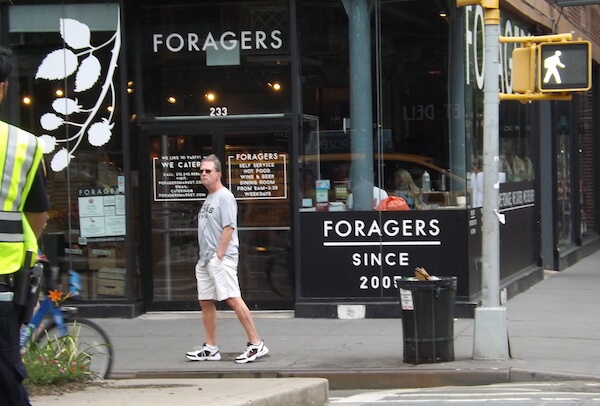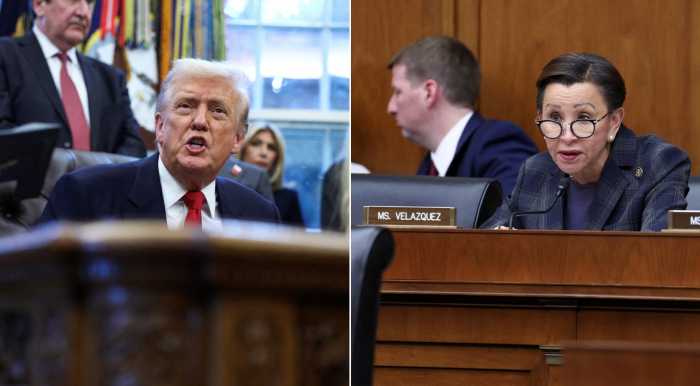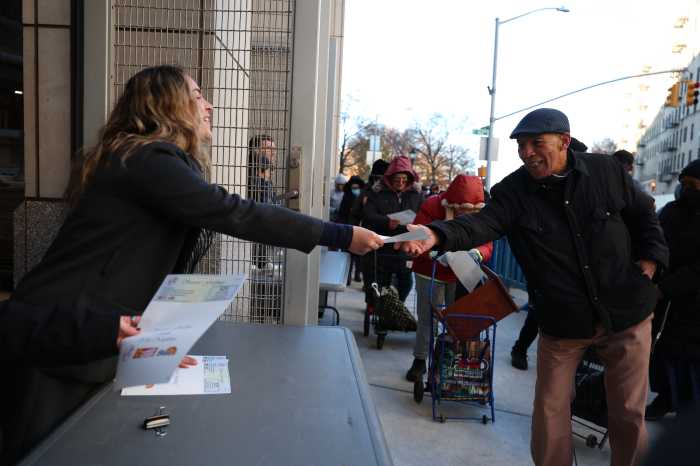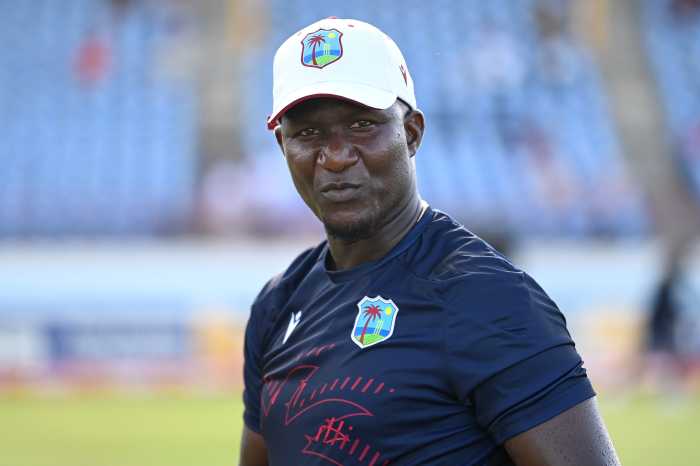This year, the Resistance contingent stepped off at roughly 5 p.m. in a parade that began at noon. | DONNA ACETO
A controversial Pride Parade route that was intended to reduce the time the annual event takes to complete shaved just 24 minutes off the march compared to last year’s march and it was still longer than the 2016 and 2015 parades.
“I have to say that the rationale for the route was an insidious collusion between the organizers of the Pride Parade and the NYPD,” said Natalie James, who led the organizing for a Resistance contingent in this year’s parade. “I think it’s very much an idea of crowd control from the NYPD.”
This year’s route was staged in Chelsea then headed south on Seventh Avenue then east on Christopher and Eighth Streets then north on Fifth Avenue to end at 29th Street.
Heritage of Pride (HOP), the group that organizes the annual parade and related events, offered various explanations for the new route, which was roundly opposed by LGBTQ activists. Among those reasons was the need to reduce the parade’s duration. The parade steps off at noon.
Critics say change was a fail, but Pride exhibited its customary exuberance
This year, Gay City News first briefly followed some of the early groups on Seventh Avenue, then the Resistance contingent for the entire length of the route, and then returned to follow the final group in the parade. That last group, YAI, which works with people with intellectual and developmental disabilities, arrived at the parade’s end at 29th Street at 9:14 p.m.
The 2017 parade, which went from Midtown to the West Village, ended at 9:38 p.m. The 2016 and 2015 parades took eight hours to complete.
HOP has said that this year’s route was a test in anticipation of the expected larger crowds for the 2019 march, which will mark the 50th anniversary of the Stonewall riots that mark the start of the modern LGBTQ rights movement. New York will also play host at the same time next year to World Pride.
Gays Against Guns, formed in the wake of the 2016 deadly shootings at Orlando's Pulse nightclub, marched as part of the Resistance. | DONNA ACETO
The GAG contingent included the veiled Human Beings, representing those lost to gun violence. | DONNA ACETO
The GAG contingent staged a die-in on Christopher Street near the Stonewall Inn. | DONNA ACETO
Since the first march in 1970, the parade routes have traveled from the West Village to Central Park for a rally or from Midtown to the West Village. The sole exception was the 1994 march, which marked the 25th anniversary of the Stonewall riots, that traveled on First Avenue past the United Nations building. Because it ended at a location with no particular significance in LGBTQ community history, the 2018 route was derided as a march to nowhere.
“For all the bad blood and tension and unnecessary time waiting that Heritage of Pride caused each of our community groups with wristbands and fretting about a march route that went nowhere, the fact that we saved 24 minutes is shocking,” said Ken Kidd, who led the organizing for a Resistance contingent in 2017.
Even if many attendees were unaware of the new route until the day of the parade, the event exhibited its customary exuberance. | DONNA ACETO
As always, the June 24 parade was an exuberant and colorful event that showcased the LGBTQ community’s diversity and its political views and successes. Gay City News interviewed an entirely unscientific sample of viewers. They mostly approved of the new route though they consistently reported learning about it only recently, with some saying that they found a place to view on Seventh Avenue by following the crowd.
“The problem was even the cops couldn’t tell us where to stand,” said Shirley McKinley as she watched with friends.
Judging by the crowd size on Seventh Avenue, it appears that the late notification to the LGBTQ community about the change did not affect turnout. It certainly did not affect the cheering by the crowd.
David Steeil and Anthony Ginexi, who were recently married, have watched the parade together in the West Village for five years. Typically, the contingents were less spirited by the time they arrived, they said.
“We always stand around this area so we always see it last,” Steeil said as they watched the first groups go by on Seventh Avenue.
David Steeil and Anthony Ginexi, who have watched the parade in the West Village for the past five years, said the contingents had more vigor this year from their vantage point because they had only recently started their trek. | DUNCAN OSBORNE
“I like it,” said Ashley Marchlinski as she stood on Fifth Avenue. “It makes no difference at all. I’m just happy to be here.”
A few said they were reserving judgment on the route. Some opposed it.
“I don’t like it,” said Steve Henaghan, who has attended the Pride Parade since 1976. “It’s too short and it doesn’t end in the West Village or Central Park… It has no reason to end [at 29th Street].”
Emma González, a bisexual anti-gun activist who helped organize student protests this past spring after her Parkland, Florida, school was the target of a mass shooting on Valentine's Day. | DONNA ACETO
HOP first began discussing the new route in December 2016. It engaged with further discussion with city agencies, including the NYPD, starting in August 2017 with the NYPD, which issues the permits for marches. Choosing from among six choices offered by HOP, the NYPD selected the route on January 22, 2018. The LGBTQ community was informed much later, with many attendees saying they learned about the route the day of the parade.
In 2010, the NYPD sought to reduce the cost of policing parades and required all parades to last five hours or less. While the Pride Parade may have lasted that long in its early years, it has not been close to five hours long in years.
The Pride Parade is among the four largest events that the NYPD polices and it is the only one of the four that is organized by a non-profit. The other three — New Year’s Eve, the 4th of July, and the Thanksgiving Day Parade — are commercial ventures. It is not clear that the NYPD actually cares about the Pride Parade’s time.
“This is one of the largest parades in New York City,” said James Kehoe, the executive officer in the Patrol Borough Manhattan South, during a June 22 press event at NYPD headquarters. “It is one of the largest street events that we do… If it goes long, it goes long.”
Asked if the NYPD’s position was that the Pride Parade was not required to last five hours, Kehoe said, “I would say that is not the position. We want to make sure that it is a successful event. We would like the parade to mirror those of the other parades, but we understand it is a large event.”
Activists, who were organized as the Reclaim Pride Coalition, also demanded that HOP rescind its requirement that all parade contingents have 200 members or fewer and that all marchers wear HOP-issued wristbands. The Coalition also wanted the policing to be restrained and that the use of police barricades be reduced.
A portion of the Resistance contingent protested the requirement that marchers wear official wristbands. | DONNA ACETO
The No Wristband contingent threw barricades onto the sidewalk at 17th Street and Eighth Avenue in order to access the parade without the required wristbands. | DUNCAN OSBORNE
The contingent ripped up a giant ring of connected wristbands in front of the judges' reviewing stand at Fifth Avenue and Eighth Street. | DUNCAN OSBORNE
A man who appeared to be an undercover police officer followed the No Wristband group from where they gathered to the staging area. | DUNCAN OSBORNE
A faction in the Resistance contingent, which formed last year as a response to Donald Trump winning the White House, protested the wristbands policy by showing up at 17th Street and Eighth Avenue, where the Resistance was staged, without wristbands and demanding to be allowed on the block. The group was followed by a man who appeared to be an undercover police officer from where protesters first gathered to the staging block. After a physical struggle over the barricades on the block between HOP volunteers and the protestors, that faction removed them and tossed them aside. Later, at Fifth Avenue and Eighth Street that group tore up a large mock-up of an HOP wristband and chains made of wristbands and threw them at the judges on the reviewing stand there.
Conflicts over the march and rally have been a common feature of the annual events since the earliest days of the movement.
HOP did not respond to a request for comment.




























